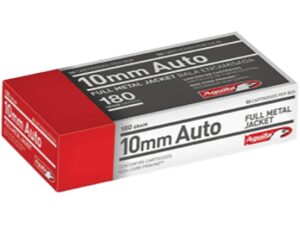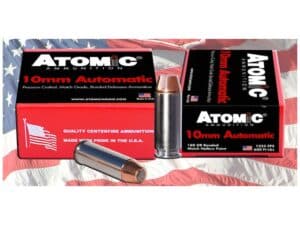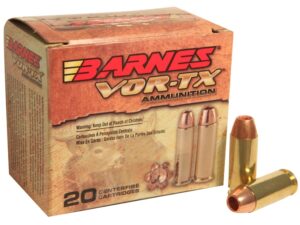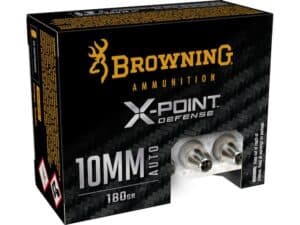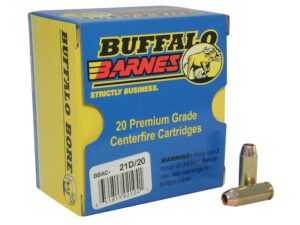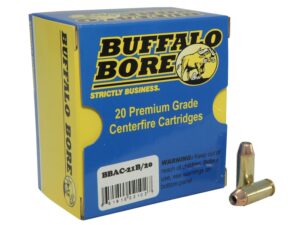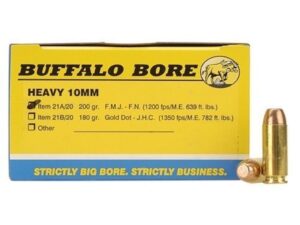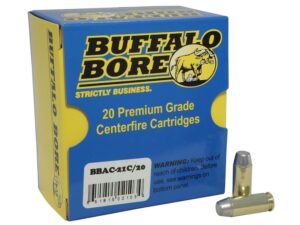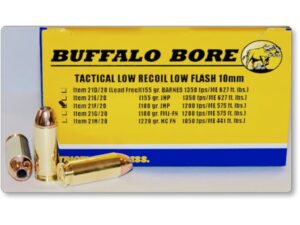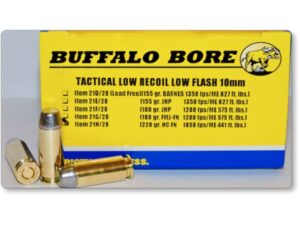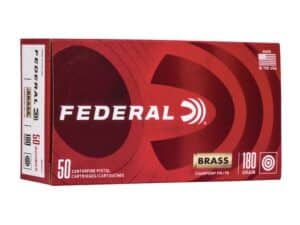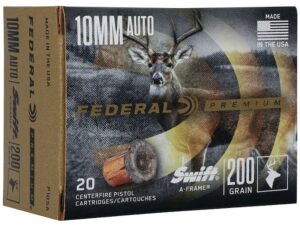10mm Ammo for Sale
-
10mm Ammo for Sale
500 Rounds of Atomic Ammunition 10mm Auto 180 Grain Bonded Match Hollow Point Box of 50 For Sale
Original price was: $600.00.$480.00Current price is: $480.00. Add to cart -
10mm Ammo for Sale
500 Rounds of Buffalo Bore Ammunition 10mm Auto 180 Grain Jacketed Hollow Point Box of 20 For Sale
$1,185.00 Add to cart -
10mm Ammo for Sale
500 Rounds of Federal Fusion Ammunition 10mm Auto 200 Grain Bonded Soft Point Box of 20 For Sale
Original price was: $1,100.00.$880.00Current price is: $880.00. Add to cart -
10mm Ammo for Sale
500 Rounds of Federal Premium Ammunition 10mm Auto 200 Grain Swift A-Frame Jacketed Hollow Point Box of 20 For Sale
Original price was: $1,155.00.$884.40Current price is: $884.40. Add to cart -
10mm Ammo for Sale
500 Rounds of Federal Premium Personal Defense Ammunition 10mm Auto 200 Grain HST Jacketed Hollow Point Box of 20 For Sale
Original price was: $1,275.00.$1,020.00Current price is: $1,020.00. Add to cart -
10mm Ammo for Sale
500 Rounds of Federal Premium Personal Defense Punch Ammunition 10mm Auto 200 Grain Jacketed Hollow Point Box of 20 For Sale
Original price was: $950.00.$760.00Current price is: $760.00. Add to cart
10mm ammo is a powerful handgun cartridge that offers a balance of speed, accuracy, and stopping power. It was developed in the 1980s by Jeff Cooper, a famous firearms expert and founder of the American Pistol Institute. Cooper wanted a cartridge that could outperform the 9mm and .45 ACP in terms of penetration and terminal ballistics, while still being manageable in a semi-automatic pistol. He collaborated with Norma, a Swedish ammunition manufacturer, to create the 10mm Auto.
Key Points
- 10mm ammo is a powerful handgun cartridge that offers a balance of speed, accuracy, and stopping power.
- It was developed in the 1980s by Jeff Cooper and Norma as an improvement over the 9mm and .45 ACP.
- It was initially adopted by the FBI but later replaced by the .40 S&W due to its excessive recoil and blast.
- It has experienced a resurgence of interest in recent years among handgun enthusiasts who appreciate its versatility and power.
- It can be used for self-defense, hunting, target shooting, and competition.
- It can fire bullets ranging from 135 to 230 grains, with velocities from 1,000 to 1,600 feet per second.
- It can deliver more energy and penetration than most handgun cartridges, making it effective against both human and animal threats.
- It can be chambered in a variety of pistols and carbines, offering more options for shooters.
- It has some disadvantages, such as high recoil, muzzle blast, cost, availability, and magazine capacity.
- It is not recommended for beginners or inexperienced shooters who may not be able to handle its power and recoil.
- It is best suited for experienced shooters who want a powerful and versatile cartridge that can handle any situation.
In this article, we will cover everything you need to know about 10mm ammo, including its history, specifications, performance, advantages, disadvantages, applications, and best choices. We will also compare it with other popular handgun cartridges, such as the 9mm, .45 ACP, and .40 S&W. We will also provide some real user experiences from people who have used 10mm ammo for different purposes. By the end of this article, you will have a better understanding of what 10mm ammo can do and whether it is right for you.
10mm Ammo For Sale In Stock
We have a vast selection of 10mm ammo for sale in stock and ready to ship. We provide discreet delivery for all orders and excellent customer service that can assist you in choosing the right ammunition for your firearm. Here’s a list of our top 10mm ammunition offerings which are available in our shop.
History of 10mm Ammo
The history of 10mm ammo can be traced back to the 1970s, when Jeff Cooper, a renowned firearms expert and founder of the American Pistol Institute, envisioned a new handgun cartridge that would combine the best features of the 9mm and the .45 ACP.
He wanted a cartridge that would have a large bullet diameter, high velocity, flat trajectory, and deep penetration, while still being manageable in a semi-automatic pistol. He called this ideal cartridge the “.40 Super”, and he began to look for a suitable platform and ammunition manufacturer to make it a reality.
In 1983, Cooper met with Dornaus & Dixon, a small firearms company that was developing a new pistol called the Bren Ten. The Bren Ten was based on the CZ-75 design, but modified to handle more powerful cartridges.
Cooper suggested that Dornaus & Dixon should chamber the Bren Ten in his .40 Super concept, and they agreed. Cooper then contacted Norma, a Swedish ammunition manufacturer, and asked them to produce the .40 Super cartridge. Norma agreed, but they made some changes to Cooper’s original specifications.
They increased the bullet diameter from .400 to .401 inches, and they increased the case length from 0.85 to 0.992 inches. They also increased the maximum pressure from 33,000 to 37,500 psi. The result was a new cartridge that was officially named the 10mm Auto.
The 10mm Auto was first introduced to the public in 1984, along with the Bren Ten pistol. The initial load offered by Norma was a 200-grain full metal jacket bullet with a muzzle velocity of 1,200 feet per second and a muzzle energy of 635 foot-pounds.
This load was very powerful and impressive, but it also had some drawbacks. It generated a lot of recoil and muzzle blast, which made it difficult to control and shoot accurately. It also required a large and heavy pistol frame to handle the pressure and recoil. The Bren Ten pistol suffered from reliability issues and poor quality control, and it soon went out of production.
The 10mm Auto cartridge also faced competition from other handgun cartridges that were gaining popularity at the time, such as the .41 Magnum and the .357 SIG.
However, the 10mm Auto got a boost in 1989, when it was adopted by the FBI as their standard service cartridge. The FBI was looking for a new handgun cartridge that would offer better performance than the 9mm and the .38 Special, which had failed to stop some assailants in several high-profile shootouts.
The FBI tested several handgun cartridges, including the .45 ACP, the .357 Magnum, and the 10mm Auto. They found that the 10mm Auto had the best balance of power, accuracy, and penetration among all the candidates. They decided to adopt the 10mm Auto as their official service cartridge, and they ordered 10,000 pistols chambered in 10mm Auto from Smith & Wesson. These pistols were based on the Model 1076 design, but modified to meet the FBI’s specifications.
However, soon after adopting the 10mm Auto, the FBI realized that it had some problems with it. The full-power load offered by Norma was too powerful and recoiling for some agents, especially those with smaller hands or less training. The recoil also caused excessive wear and tear on the pistols and reduced their service life.
The FBI decided to reduce the load of the 10mm Auto to make it more controllable and comfortable for their agents. They asked Smith & Wesson to develop a new load that would have a muzzle velocity of 980 feet per second and a muzzle energy of 390 foot-pounds. This load was called the “FBI Lite” or “10mm Lite”, and it became the standard issue load for the FBI.
However, this reduced load also reduced the performance of the 10mm Auto. It lost its edge over other handgun cartridges in terms of power and penetration. It also became redundant with another cartridge that was being developed at the same time: the .40 S&W. The .40 S&W was essentially a shortened version of the 10mm Auto with similar ballistics.
It was created by Smith & Wesson and Winchester as a response to the FBI’s request for a new handgun cartridge that would fit in a smaller and lighter pistol frame than the 10mm Auto. The .40 S&W was introduced in 1990, along with several pistols chambered in it from various manufacturers.
The .40 S&W quickly became more popular than the 10mm Auto among law enforcement and civilian shooters. It offered almost identical performance as the 10mm Lite, but with less recoil, blast, and cost. It also had a higher magazine capacity and a wider selection of pistols and ammunition.
The FBI eventually switched from the 10mm Auto to the .40 S&W in 1995, and many other law enforcement agencies followed suit. The 10mm Auto was largely abandoned by the mainstream market, and it became a niche cartridge for a small group of enthusiasts.
However, in recent years, the 10mm Auto has experienced a resurgence of interest and popularity among handgun aficionados who appreciate its versatility and power. The 10mm Auto can be used for a variety of purposes, such as self-defense, hunting, target shooting, and competition.
It can fire bullets ranging from 135 to 230 grains, with velocities from 1,000 to 1,600 feet per second. It can deliver more energy and penetration than most handgun cartridges, making it effective against both human and animal threats. It can also be chambered in a variety of pistols and carbines, offering more options for shooters.
Some of the factors that have contributed to the revival of the 10mm Auto are:
- The availability of more pistols and carbines chambered in 10mm Auto from various manufacturers, such as Glock, SIG Sauer, Colt, Kimber, Ruger, Dan Wesson, Rock Island Armory, EAA, CMMG, Kriss Vector, and others.
- The availability of more ammunition choices in 10mm Auto from various manufacturers, such as Federal, Hornady, Remington, Winchester, Speer, Underwood, Buffalo Bore, DoubleTap, Cor-Bon, and others.
- The increased demand for powerful and versatile handgun cartridges for self-defense and hunting in an era of social unrest and wildlife encounters.
- The increased interest in handgun hunting as a challenging and rewarding sport.
- The increased popularity of handgun competitions that favor powerful and accurate cartridges, such as USPSA/IPSC Major Power Factor and Steel Challenge.
- The influence of celebrities and media personalities who promote the 10mm Auto as their preferred cartridge, such as Joe Rogan, Colion Noir, Hickok45, Paul Harrell, and others.
The 10mm Auto is now considered by many to be one of the best handgun cartridges available today. It offers a balance of speed, accuracy, and stopping power that few other cartridges can match. It is also one of the most versatile cartridges that can handle any situation. Whether you need a cartridge for self-defense, hunting, target shooting, or competition, the 10mm Auto can do it all.
10mm Ammo Dimension
The 10mm Ammo has 1.56 milliliter (24.1 grain H2O) cartridge case capacity.
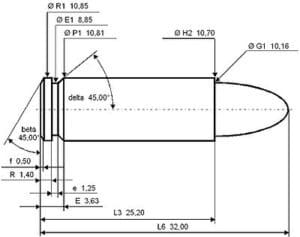
The typical rifling twist rate of the 10mm cartridge is 406.40 millimeters (1 for 16 inches). Six grooves, O land equal 9.91 millimeters (.390 in), O grooves equal 10.17 millimeters (.4005 in), and land width equal 3.05 3 millimeters (.120 inches). Small or large pistol primer is utilized.
The Commission Internationale Permanente pour l’Epreuve des Armes a Feu Portatives (C.I.P. ; Permanent International Commission for the Proof of Small Arms) rules state the maximum pressure as 223 MPa (33,000 psi). In C.I.P. states, every gun/cartridge combination has to be tested with 130% pressure. The maximum C.I.P. to allow sales to the public.
The sporting Arms and Ammunition Manufacturers Institute (SAAMI) maximum pressure limit for the 10mm Auto is 37500 PSI (259 MPa).
Specifications of 10mm Ammo
The 10mm Auto is a rimless, straight-walled, centerfire handgun cartridge that has a bullet diameter of 0.401 inches, a case length of 0.992 inches, and an overall length of 1.26 inches. It has a maximum pressure of 37,500 psi, as defined by the Sporting Arms and Ammunition Manufacturers’ Institute (SAAMI). It has a standard primer size of large pistol.
The 10mm Auto can fire bullets ranging from 135 to 230 grains, with velocities from 1,000 to 1,600 feet per second. The muzzle energy of the 10mm Auto can vary from 350 to 800 foot-pounds, depending on the load and bullet weight. The table below shows some examples of common 10mm Auto loads and their ballistics:
| Bullet Weight | Bullet Type | Muzzle Velocity | Muzzle Energy | Manufacturer |
|---|---|---|---|---|
| 135 gr | JHP | 1,600 fps | 767 ft-lbs | Cor-Bon |
| 155 gr | JHP | 1,475 fps | 675 ft-lbs | Federal |
| 165 gr | JHP | 1,400 fps | 645 ft-lbs | Hornady |
| 180 gr | FMJ | 1,150 fps | 529 ft-lbs | Winchester |
| 200 gr | FMJ | 1,050 fps | 490 ft-lbs | Remington |
| 230 gr | FMJ | 950 fps | 461 ft-lbs | Underwood |
JHP stands for jacketed hollow point, which is a type of bullet that expands upon impact and creates a larger wound channel. FMJ stands for full metal jacket, which is a type of bullet that does not expand and penetrates deeper.
The recoil of the 10mm Auto can vary from moderate to severe, depending on the load and the pistol. The recoil impulse of the 10mm Auto can range from 6 to 12 pounds-force, depending on the load and bullet weight. The table below shows some examples of recoil impulses for different 10mm Auto loads and pistols:
| Load | Pistol | Recoil Impulse |
|---|---|---|
| Cor-Bon 135gr | Glock 20 | 9.8 lbf |
| Federal 155gr | Colt Delta Elite | 8.6 lbf |
| Hornady 165gr | SIG Sauer P220-10 | 8.3 lbf |
| Winchester 180gr | Ruger Blackhawk | 7.2 lbf |
| Remington 200gr | Dan Wesson Razorback | 6.7 lbf |
| Underwood 230gr | Kriss Vector Carbine | 6.3 lbf |
The recoil impulse is calculated using the formula:
$$Recoil Impulse = \frac{Bullet Weight \times Muzzle Velocity + Powder Charge \times Ejection Velocity}{Gun Weight}$$
The powder charge and ejection velocity are estimated based on typical values for handgun cartridges.
The recoil impulse is a measure of the momentum transfer from the cartridge to the gun, and it affects how much the gun moves backward when fired. A higher recoil impulse means more recoil and more difficulty in controlling the gun.
The recoil energy is another measure of the recoil force, and it affects how much the gun pushes against the shooter’s hand when fired. A higher recoil energy means more felt recoil and more discomfort for the shooter.
The recoil energy is calculated using the formula:
$$Recoil Energy = \frac{Recoil Impulse^2}{2 \times Gun Weight}$$
The recoil energy is measured in foot-pounds, and it can range from 5 to 20 foot-pounds, depending on the load and the gun. The table below shows some examples of recoil energies for different 10mm Auto loads and pistols:
| Load | Pistol | Recoil Energy |
|---|---|---|
| Cor-Bon 135gr | Glock 20 | 19.6 ft-lbs |
| Federal 155gr | Colt Delta Elite | 15.9 ft-lbs |
| Hornady 165gr | SIG Sauer P220-10 | 14.5 ft-lbs |
| Winchester 180gr | Ruger Blackhawk | 11.2 ft-lbs |
| Remington 200gr | Dan Wesson Razorback | 9.7 ft-lbs |
| Underwood 230gr | Kriss Vector Carbine | 8.6 ft-lbs |
The recoil energy is a measure of the work done by the recoil force, and it affects how much the gun vibrates and heats up when fired. A higher recoil energy means more stress and fatigue for the gun and the shooter.
The recoil of the 10mm Auto can be reduced by using lighter loads, heavier guns, or recoil-reducing devices, such as muzzle brakes, compensators, recoil springs, or recoil buffers. However, these methods may also affect the performance, reliability, or accuracy of the cartridge or the gun.
The recoil of the 10mm Auto can be compared to other handgun cartridges by using a recoil factor, which is calculated by multiplying the recoil impulse by the recoil energy. The recoil factor is a dimensionless number that represents the overall magnitude of the recoil. The table below shows some examples of recoil factors for different handgun cartridges and loads:
| Cartridge | Load | Recoil Factor |
|---|---|---|
| .22 LR | CCI Mini-Mag 40gr | 0.2 |
| .380 ACP | Federal Hydra-Shok 90gr | 1.2 |
| 9mm Luger | Speer Gold Dot 124gr | 2.7 |
| .40 S&W | Winchester Ranger T-Series 180gr | 4.3 |
| .45 ACP | Federal HST +P 230gr | 5.1 |
| .357 Magnum | Hornady Critical Defense 125gr | 8.3 |
| .44 Magnum | Federal Fusion Soft Point 240gr | 16.4 |
| 10mm Auto | Cor-Bon JHP 135gr | 38.4 |
As you can see, the recoil factor of the full-power 10mm Auto load is much higher than most other handgun cartridges, and it is comparable to some rifle cartridges. This means that the shooter needs to have a lot of skill and experience to handle the recoil of the 10mm Auto effectively.
The recoil of the 10mm Auto can also be subjective, depending on the shooter’s perception, tolerance, and preference. Some shooters may find the recoil of the 10mm Auto manageable and enjoyable, while others may find it too harsh and unpleasant. The shooter’s personal preference may also depend on the purpose and context of using the 10mm Auto. For example, a shooter may tolerate the recoil of the 10mm Auto better when hunting than when target shooting, because the adrenaline and excitement of hunting may mask the recoil sensation. Conversely, a shooter may prefer the recoil of the 10mm Auto over other cartridges when target shooting, because the recoil may provide a challenge and a thrill that enhance the shooting experience.
The bottom line is that the recoil of the 10mm Auto is not for everyone, and it requires a lot of practice and training to master. The shooter needs to have a proper grip, stance, and technique to control the recoil and shoot accurately. The shooter also needs to have a suitable pistol and ammunition that match their needs and preferences. The 10mm Auto is not recommended for beginners or inexperienced shooters who may not be able to handle its power and recoil. The 10mm Auto is best suited for experienced shooters who want a powerful and versatile cartridge that can handle any situation.
10mm Ballistics and Performance
The 10mm really shines when you look at its ballistic performance and wounding potential. The table below compares 10mm ballistics with common defensive pistol calibers using similar bullet weights:
| Ammunition | Bullet Weight | Muzzle Velocity | Muzzle Energy |
|---|---|---|---|
| 10mm Auto | 155 gr | 1250 fps | 624 ft-lbs |
| 10mm Auto | 180 gr | 1150 fps | 616 ft-lbs |
| .40 S&W | 155 gr | 1125 fps | 412 ft-lbs |
| .40 S&W | 180 gr | 975 fps | 396 ft-lbs |
| 9mm Luger | 115 gr | 1180 fps | 364 ft-lbs |
| 9mm Luger | 124 gr | 1120 fps | 369 ft-lbs |
| .45 ACP | 230 gr | 830 fps | 356 ft-lbs |
It’s clear the 10mm provides a significant step up in velocity and energy over other calibers. The slower 230 grain .45 ACP is no match for a lighter 10mm bullet at over 1,100 fps.
This performance advantage does come at the cost of increased felt recoil. However, with a proper grip, stance, and fundamentals, an experienced shooter can deliver fast follow-up shots.
The 10mm’s impressive ballistics are partly thanks to its relatively large case capacity. The 10mm case measures .992″ long vs. .898″ for .45 ACP. This allows more space for powder resulting in higher pressures and velocity.
The common 10mm bullet weights are:
- 115 gr: The lightest 10mm bullets suitable for target shooting. 115 grain 10mm likely won’t expand as intended in self-defense.
- 124 gr: Another option for the range. 124 grain expands more reliably than 115 grain 10mm.
- 135 gr: Provides a good balance of velocity and expansion for self-defense.
- 155 gr: A great weight for personal defense in the 10mm caliber. Expands fully and penetrates deeply.
- 165 gr: On the heavier side for expanding 10mm ammo. Optimized for hunting medium-sized game.
- 180 gr: The heaviest common 10mm bullet weight. Provides max penetration and energy transfer. Best for handgun hunting applications.
The most common load types available include:
- Full Metal Jacket (FMJ): Inexpensive range ammo with no expansion. The round penetrates deeply.
- Total Metal Jacket (TMJ): Similar ballistics to FMJ with a covered base for reduced lead fouling.
- Jacketed Hollow Point (JHP): Designed to expand on impact while preventing over-penetration. Top choice for self-defense.
- Hard Cast Lead: Cast lead bullets allow for heavy-for-caliber weights. Great for hunting and maximum penetration.
- Hunting: Specialized big game hunting loads using sturdy bonded bullets for deep penetration.
With the right ammo choice, the 10mm shines in roles from plinking and competition to self-defense and hunting.
Best Uses for the 10mm Auto
With its broad range of bullet weights and designs, the 10mm serves multiple purposes limited only by the gun’s size and ammunition cost. Here are the most common 10mm applications:
Home and Self Defense
The 10mm’s stopping power is ideal for home defense. The best 10mm ammo for self-defense purposes will be a modern expanding hollow point bullet in a weight like 135, 155, or 165 grains.
Top personal defense loads from Federal, Hornady, Winchester, and others utilize proprietary bullet designs to achieve 14″-16″+ of penetration while expanding to .60 to .70 caliber in testing. Many also use low flash powders to preserve night vision.
The only downsides to 10mm for defense are increased recoil and potentially too much penetration compared to smaller calibers. Proper shot placement helps mitigate these risks. Overall, the 10mm provides excellent stopping power and fast follow-up shots in the right hands.
Hunting & Outdoors
It’s in hunting applications where the 10mm really shines. The flat trajectory and penetration are enough to humanely take medium game like whitetail deer within reasonable distances.
For hunting purposes, look for sturdy controlled expansion or hard cast lead bullets in weights like 165 grain, 180 grain, or 200 grain. Buffalo Bore, Underwood, and Grizzly Cartridge offer excellent hunting loads for 10mm Auto.
The 10mm has also proven itself as a backup gun when hiking or fishing in bear country. It provides more power than smaller calibers if needed to stop an aggressive bear.
Competition & Target Shooting
The 10mm has a following in action shooting sports like IDPA thanks to its magazine capacity and powerful loads. For competitions, consistent cycling lightweight practice ammo is a must. Look for affordable FMJ practice ammo around 115 grains or so.
The 10mm also works for casual target practice. While not as cheap to shoot as 9mm, it does offer low recoil load options. Blazer Brass and Speer Lawman make affordable 10mm TMJ rounds ideal for extended range sessions.
The 10mm may never become a bullseye shooting cartridge, but it performs admirably for defensive pistol sports and range training.
“The flat shooting, heavy hitting, potentially accurate round remains popular among sport shooters and handgun hunters. The 10mm retains just enough mainstream support to stick around, year after year.”
– The National Interest
considerations for Self-Defense vs Target Shooting
Choosing the right 10mm ammo is key to harnessing its potential. The best 10mm loads for personal defense and hunting differ from affordable range ammunition. Here are some factors to consider:
Bullet Weight
- Lighter bullets like 115 gr and 124 gr work well for target shooting. They have manageable recoil for extended range sessions.
- For self-defense, look for 135 gr, 155 gr, or 165 gr bullets. These provide the best balance of penetration and expansion.
- 180 gr and heavier bullets are idea for hunting medium game or outdoor defense against large animals.
Bullet Expansion
- For defensive use, choose a modern jacketed hollow point (JHP) bullet. These are engineered to penetrate deeply while expanding to 1.5 times their original diameter.
- Total metal jacket (TMJ) and full metal jacket (FMJ) rounds don’t expand. They offer affordable target shooting but aren’t ideal for personal defense.
Recoil Management
- Although manageable for most shooters, 10mm has more recoil than lighter calibers like 9mm. Use a firm grip and proper stance to help control it.
- Less-experienced shooters may prefer lighter 115 gr or 124 gr target loads to start. Work up to full power 155 gr or 165 gr defense loads.
- Competitive shooters who run 10mm often use compensators or ports on their pistols to reduce muzzle flip. These aid faster follow-up shots.
Cost Per Round
- Expect to pay $0.75 – $1.50+ per round for premium hollow point defense ammunition. This is approximately 2-3 times the cost of 9mm FMJ range ammo.
- More affordable options for high-volume shooting include TMJ and remanufactured FMJ loads costing $0.40 – $0.60 per round.
- Consider stepping down to a cheaper caliber like 9mm if tight budget constraints limit 10mm practice. It takes consistent training to master 10mm recoil.
With proper ammo selection and training, the 10mm fulfills any role from plinking to hunting with authority. Understand your needs and choose ammunition accordingly.
The Pros and Cons of 10mm Ammo
Interested in whether the 10mm is right for you? Here’s a quick run-down of the pros and cons based on our discussion:
The Pros
- Highest velocity and energy of any semi-auto handgun round
- Excellent stopping power and penetration for defense/hunting
- Broad range of bullet weights for any use case
- High magazine capacities possible in full-size pistols
- Straight shooting trajectory up to 100+ yards
The Cons
- Increased recoil takes practice to manage effectively
- Over-penetration risk compared to smaller pistol calibers
- Ammo costs 2-3X as much as more common calibers
- Limited firearms selection compared to 9mm, .40 S&W, or .45 ACP
- Shorter pistol barrels reduce full 10mm potential
Like any tool, the 10mm has trade-offs. For shooters able to master its recoil, it provides an unrivaled combination of power and capacity. While niche, its loyal following will continue thanks to its proven capabilities.
Availability and Cost of 10mm Ammo
The 10mm faces no imminent risk of obsolescence but has never reached the widespread popularity of, say, 9mm or .45 ACP. The major ammunition and firearms companies continue producing guns and ammo, though, ensuring the 10mm is here to stay.
Ammo Selection
While not found in every gun store, most retailers carry at least a basic FMJ target loading along with a few hunting and self-defense options. Online ammo retailers offer the widest variety of 10mm at competitive prices.
Ammo Cost
Expect to pay a premium over larger pistol calibers:
- 10mm FMJ practice ammo runs $0.40 – $0.60 per round
- 10mm JHP defense ammo costs $0.75 to $1.50+ per round
For comparison, 9mm FMJ can be found for under $0.20/round while 9mm defense ammo costs $0.50 – $1.00 per round. The 10mm costs about 2-3 times as much for practice and defense ammunition.
Gun Availability
Every major pistol manufacturer offers at least one 10mm model, but selection is still dwarfed by the ubiquity of 9mm handguns. Glock, SIG, Smith & Wesson, Kimber, Rock Island, and others all produce 10mm pistols.
Reloading 10mm
Reloading helps offset the higher cost of 10mm ammo. Handloading allows tuning loads precisely for your needs. However, reloading 10mm requires attention to detail – improper loads can cause catastrophic failures.
Frequently Asked Questions About 10mm Ammo
Here are answers to some of the most common questions about the 10mm Auto:
Is 10mm a good self defense round?
With modern hollow point loads, the 10mm is an excellent self-defense cartridge. It provides superior stopping power to smaller calibers like 9mm and .40 S&W. However, it requires training to control the stout recoil for fast, accurate follow-up shots.
Is 10mm good for concealed carry?
Full-size 10mm handguns are suitable for open carry but generally too large for comfortable concealed carry. Subcompact 10mm pistols like the Glock 29 are viable concealed carry options but have significant recoil in this role.
What guns use 10mm?
While not as widespread as other semi-auto rounds, every major manufacturer offers 10mm pistols. Notable models include the Glock 20/29, SIG P220, Smith & Wesson 1006, Kimber Custom, and Colt Delta Elite.
Does the FBI still use 10mm?
The FBI adopted a lighter 10mm load known as the “10mm Lite” in 1989. This provided similar ballistics to the .40 S&W. By the 1990s, the FBI completely switched to .40 caliber sidearms and no longer uses 10mm pistols.
How much recoil does a 10mm have?
With full-power loads, the 10mm has approximately 30-40% more recoil than a .45 ACP. However, advances in ergonomics and recoil reduction mean the felt recoil is certainly manageable for most shooters with proper technique.
Final Thoughts on 10mm Ammo
In the right pistol, the 10mm Auto offers nearly unmatched velocity, energy transfer, and penetration. It provides versatile capabilities across defensive, hunting, and competitive shooting applications.
While the relatively high ammo cost and stout recoil temper more widespread adoption, the 10mm fills an excellent niche. It’s ideal for shooters wanting maximum semi-auto handgun performance.
Whether you already rely on a 10mm as your go-to pistol or are still weighing the pros and cons, we hope this guide gave you a comprehensive overview. The 10mm has compelling strengths for firearms enthusiasts looking to push the boundaries of handgun ballistics.

